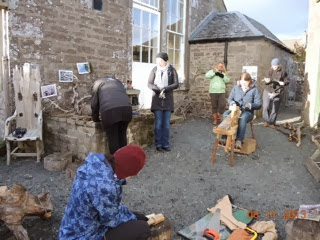After a weekend of exploring the natural and man-made elements of Edinburgh, Dunblane and Stirling by train and on foot, the tour group arrived in Crieff ready for 3 days of nature pedagogy and inspiration.

Edinburgh
 Crieff
Crieff

Guess what season it is???
'DON'T TEACH ABOUT NATURE - LEARN WITH NATURE"
Claire Warden, 2013
A brisk morning in Crieff, Scotland saw us set off in Glen's bus loaded with warm bits of clothing and open minds - to a little village named Fowlis Wester. Surrounded in a plethora of open ended play areas where the natural environment invites you to investigate and explore - was a little and very old 'cottage'. Here Claire imparted information about the background of her vision and value system embedded in Mindstretchers model of nature pedagogy. Where to start and what to include in this blog leaves me with a huge dilemma. Please consider that this to be a snapshot of my experience and I implore people to visit Claire's website for more information.
Although we need no convincing about the value of natural play spaces. Today we were challenged by discussions around the curriculum activity 'zoning' that happens in centres where specific areas are set up for specific learning outcomes. For nature education to be embedded children must have the opportunity to experience natural elements throughout all spaces - Inside, outside, beyond and it must be understood that when children explore nature - each experience is multifacetted and potentially offers a variety of learning outcomes including science, maths, literacy, language, music. Claire reiterated that educators, families and regulators have to also understand that developing children's learning dispositions such as motivation, curiosity, perseverance and confidence is of utmost importance to life long learning and that children's intrinsic connections to nature will provide the environment for these to occur. AS educators we need to make this learning visible to parents and regulators.


Kate gives us a geography lesson!
So...... some clarity of vision and values around nature play spaces and connections to education.
 Nature ... A place for relationships to develop.
Nature ... A place for relationships to develop.

A place where there is a sense of community with family - (share the journey with families - parent classes may include 'the potential of a rucksack')
A place where ALL the environments give the same core message all year round. Resources need to be in all areas - stones, tools, wood.

Auchlone Nature Kindergarten -
A place where there is a connection to real landscapes around the children.
Children are able to create links in their learning within the cultural space they live in. (Vygotsky)
A place that encourages connected thinking. CONNECTIVITY!
A place that allows you time to think.
A place where confidence and emotional resilience flourishes naturally.
A place where there are meaningful connections to home .
Nature - freedom.
The pictures tell SOME of my story today....but will never catch the beauty....

Tools anyone?

Fire House - risk assessment, tool safety - then -wittling skills, fire making, charcoal making -then -popcorn, bread and marshmellows!

See the mathematics in stick collecting?

Dens, ropes.

Playing with sunshine and shadows

The Dark Wood provides a visual boundary.

Bread - chocolate or Sundried tomato - mix it in a glad bag, heat it up against your chest, wrap around the hollow bamboo and bake over the coals you've made in your fire!

Fallen logs - the possibilities for learniNG!

Ropes and swings, undulating and varieties of surfaces - challenges for children's proprioception and vestibular systems - beats metal climbing frames anyday.

Pixies and fairies live here?

There is no such thing as bad weather - only bad clothing.

Pack up time - gather your tools. BATHTME!
 Then on to some practical skills useful when supporting children's learning through nature - Birchwood Splitting
Then on to some practical skills useful when supporting children's learning through nature - Birchwood Splitting Kate gives a lesson on using willow to create many forms for a multitude of uses - practical and creative.
Kate gives a lesson on using willow to create many forms for a multitude of uses - practical and creative.

















































